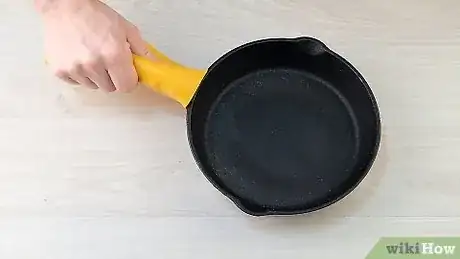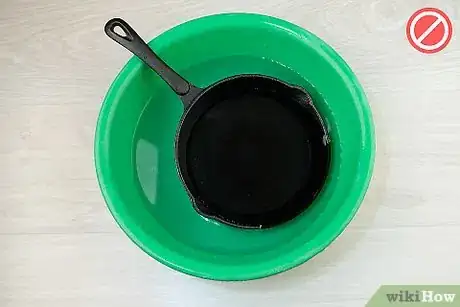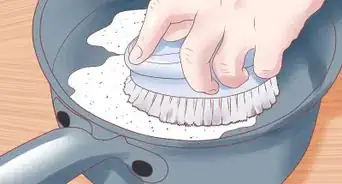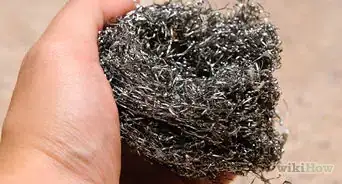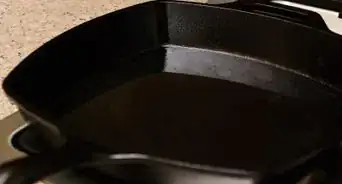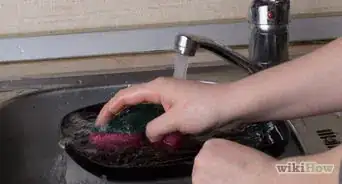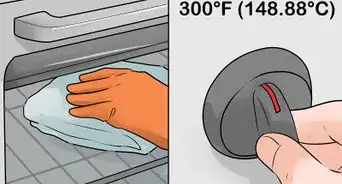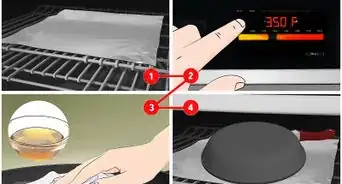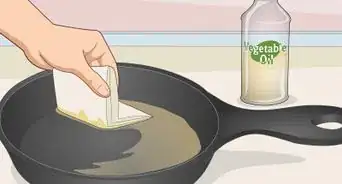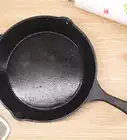This article was co-authored by Kadi Dulude. Kadi Dulude is a House Cleaning Professional and the Owner of Wizard of Homes, a New York City-based cleaning company. Kadi has over 10 years of experience and manages a team of over 90 registered cleaning professionals. Her cleaning advice has been featured in Architectural Digest and New York Magazine.
There are 15 references cited in this article, which can be found at the bottom of the page.
This article has been viewed 26,890 times.
Lodge is an established USA-based cookware brand specializing in pre-seasoned cast iron skillets, griddles, pans, woks, and dutch ovens.[1] Cast iron products may yield delicious dinners, but their cleaning needs differ significantly from those of other pots and pans. By keeping your cast iron safe from water and rust, regularly treating or seasoning cooking surfaces with oil, and ensuring proper everyday care, you can ensure years of use from your Lodge cookware (and any other cast iron products).
Steps
Hand-Washing Lodge Cast Iron after Use
-
1Protect your hands with heat-resistant grippers when handling hot cast iron. Anytime you cook with and clean your cast iron, protect your hands from burns with heat-resistant handle covers, oven mitts, or potholders.[2] Cast iron retains significant amounts of heat and cools down slowly, but you’ll want to wash, dry, and season your cookware while it is still warm.
- Food residue releases more easily from the surface of warm warm cast iron and should be removed before it bakes and hardens on.
- When applied to warm cast iron, seasoning oils will react with the metal and polymerize. This will not occur on a cool or cold surface, so do not wait for your cookware to cool down.
- Unlike the separate heat-resistant handles attached to other types of cookware, a cast iron pan is made by pouring iron into a pan-shaped mold.[3] Because the finished product is a single piece of conductive metal, heat will travel from the base upon the heat source through the sides and handles.
-
2Wash your warm cast iron with hot running water and a bristle brush. Do this immediately after each use, while the pan is still warm. Stiff nylon scrub brushes are recommended[4] as they are resilient and non-abrasive, but soft sponges will work as well. Use a medium scrubbing pressure and make sure to get into the ridges and corners of your cookware.
- Mild soap may be used on Lodge cast iron products, but is not necessary. They will become sterilized at 212 °F (100 °C) while you heat them up for cooking.[5]
Advertisement -
3Use a pan scraper to remove stuck-on food residue. Food residue releases more easily from the surface of warm cast iron and should be removed before it bakes and hardens on. Scrape gently until all residue has been removed.
-
4Dry all surfaces thoroughly with a lint-free towel.[9] [10] Whether you use a paper towel or a microfiber dishcloth, be sure to remove all droplets of moisture to prevent rust from forming.
- Cast iron cookware can also be dried over low stove-top heat or in a warm oven. This will cause any remaining moisture to evaporate.[11]
- Any dark flakes or residue that appear on your drying cloth are the result of the seasoning reacting with acidic foods. This will occur less and less as you continue to build up layers of seasoning.[12]
Cleaning Brand New Lodge Cookware
-
1Rinse off your new Lodge cast iron under hot water.[13] Before using your cookware for the first time, place your cast iron under hot running water and quickly rinse off every surface to remove any dust or packaging residue.
- Mild soap may be used on Lodge cast iron products, but is not necessary. They will become sterilized at 212 °F (100 °C) while you heat them up for cooking.[14]
-
2Dry all surfaces thoroughly with a lint-free towel. A paper towel or a microfiber dishcloth are suitable.[15] Be sure to remove all droplets of moisture from the inside, outside, and handle(s) to prevent rust from forming.
- New and unused Lodge cast iron may have a rough surface due the sand casting manufacturing process.[16] As a result of this rough surface, refrain from using non-lint-free towels to dry with as they will deposit fuzz all over the surface of your pan.
-
3Familiarize yourself with the process of cast iron seasoning. Seasoning is the process of building up layers of baked-on, hardened cooking oil. These layers provide protection against moisture and rust, and result in a natural, smooth surface that your food won’t stick to.[17]
- When applied to cast iron and baked, the fat molecules in the oil undergo a process of polymerization which results in a hard, plastic-like coating.[18]
-
4Don’t worry about seasoning brand new Lodge cookware. While other cast iron pans require some initial preparation, Lodge uses a soybean oil to pre-season its cast iron.[19] This means you can start cooking with a new Lodge pan soon after you acquire, rinse, and dry it.
Seasoning and Storing Your Lodge Cast Iron
-
1Apply a thin layer of cooking oil to your pan when it is dry but still warm. Rub the oil into the inside cooking surfaces until a light layer has been applied. Lodge manufactures a canola oil Seasoning Spray for regular use. However, any vegetable oil, canola oil, cooking spray, or shortening may be used, so long as it is safe for consumption.[20]
- You won’t need to add oil to the outside of your cookware after each use.
-
2Blot away excess pools of oil from the corners or grooves of the pan. Excess oil will not reach the surface of the warm cast iron, and will fail to polymerize and convert to seasoning. Instead, excess oils may result in a layer of sticky oil residue.[21]
- If your cast iron develops an extra layer of sticky oil, place the pan upside-down in the oven over a sheet of aluminum foil. Bake at 350 °F (177 °C) for 1 hour and allow to cool completely in the oven.[22]
-
3Look for a semi-glossy cooking surface after seasoning. Once the cooking oils have polymerized, the resulting finish should be smooth, evenly applied, semi-glossy,, and free of rust and food residue.[23] Your Lodge cast iron may have started with a rough surface, but the more times you use and season your cookware, the smoother its surface will become.
- Dull patches indicate an uneven application of oil.[24] A few blotches can be remedied through regular use and seasoning, while a completely dull surface should be restored through re-seasoning.
-
4Store your Lodge cast iron in a dry place. You may either hang up your cast iron cookware or store it flat. A paper towel should be inserted between pans if stacked vertically. To avoid condensation, do not store pans with their lids on.[25]
Extending the Lifespan of Your Lodge Cookware
-
1Refrain from cooking acidic foods in cast iron cookware. Highly acidic or alkaline foods, such as tomatoes and citrus fruits or juices, will react with and strip away protective seasoning. Wait until your cookware is highly seasoned before preparing dishes with high acid content.[26]
- Any dark flakes or residue that appear on your drying cloth are the result of the seasoning reacting with acidic foods. This will occur less and less as you continue to build up layers of seasoning.[27]
-
2Re-season the entire pan when it gets rusty or dull. Scrub the pan with steel wool to remove the dull patina and rust before washing with hot water and mild soap. Then, apply oil to the outside and inside surfaces. Place it upside-down in the oven over a sheet of aluminum foil. Bake at 350 °F (177 °C) for 1 hour before allowing to cool completely in the oven.[28] [29]
- You may repeat this process 2 to 3 times, baking on multiple layers of seasoning until the cast iron achieves a smooth, semi-glossy finish.[30]
- If you have not used your Lodge cast iron for an extended period of time, such as a year, and it has dulled or rusted while in storage, it is time to re-season it.
-
3Never soak your cast iron in standing water or wash it in the dishwasher. Exposure to significant amounts of water will quickly cause rust to form on the surface of your cast iron cookware. Dishwasher detergent and extended exposure to water will strip the protective coating established through regular seasoning from your cast iron.[31]
-
4Avoid scouring your cast iron with steel wool. Steel wool scouring pads will scratch away the protective seasoning on cast iron cookware. This exposes the cookware to moisture and rust. It will also destroy the smooth cooking surface upon which food glides easily.[32]
-
5Season your Lodge cast iron on a regular basis. If you use your cookware frequently, preparing food with cooking oil and following up with proper cleaning and seasoning, a hardy protective coating will develop along with a smooth anti-stick surface.[35]
References
- ↑ http://www.lodgemfg.com/about
- ↑ https://www.cooksillustrated.com/articles/629-testing-cast-iron-skillet-handle-covers
- ↑ http://www.lodgemfg.com/use-and-care/frequently-asked-questions
- ↑ http://www.lodgemfg.com/use-and-care/cast-iron-lets-cook
- ↑ https://www.timescolonist.com/opinion/cast-iron-pan-clash-wash-with-soap-or-not-1.2180045
- ↑ http://www.lodgemfg.com/use-and-care/cast-iron-lets-cook
- ↑ Kadi Dulude. House Cleaning Professional. Expert Interview. 22 September 2019.
- ↑ https://shop.lodgemfg.com/indoor-accessories/pan-scrapers.asp
- ↑ http://www.lodgemfg.com/use-and-care/cast-iron-lets-cook
- ↑ Kadi Dulude. House Cleaning Professional. Expert Interview. 22 September 2019.
- ↑ https://www.thekitchn.com/how-to-clean-a-cast-iron-skillet-cleaning-lessons-from-the-kitchn-107747
- ↑ http://www.lodgemfg.com/use-and-care/cast-iron-lets-cook
- ↑ James Sears. House Cleaning Professional. Expert Interview. 28 August 2019.
- ↑ https://www.timescolonist.com/opinion/cast-iron-pan-clash-wash-with-soap-or-not-1.2180045
- ↑ http://www.lodgemfg.com/use-and-care/cast-iron-lets-cook
- ↑ http://www.lodgemfg.com/use-and-care/frequently-asked-questions
- ↑ https://www.popsci.com/season-cast-iron-pan
- ↑ https://www.popsci.com/season-cast-iron-pan
- ↑ http://www.lodgemfg.com/use-and-care/frequently-asked-questions
- ↑ http://www.lodgemfg.com/use-and-care/cast-iron-lets-cook
- ↑ http://www.lodgemfg.com/use-and-care/what-is-seasoning
- ↑ http://www.lodgemfg.com/use-and-care/what-is-seasoning
- ↑ https://traditionalcookingschool.com/food-preparation/how-to-season-cast-iron-when-to-re-do-it-aw062/
- ↑ https://traditionalcookingschool.com/food-preparation/how-to-season-cast-iron-when-to-re-do-it-aw062/
- ↑ https://www.epicurious.com/expert-advice/how-to-wash-season-and-maintain-cast-iron-cookware-article
- ↑ https://www.thekitchn.com/5-myths-of-cast-iron-cookware-206831
- ↑ http://www.lodgemfg.com/use-and-care/cast-iron-lets-cook
- ↑ https://www.youtube.com/watch?v=Gg6S6vWyPH8
- ↑ Kadi Dulude. House Cleaning Professional. Expert Interview. 22 September 2019.
- ↑ https://traditionalcookingschool.com/food-preparation/how-to-season-cast-iron-when-to-re-do-it-aw062/
- ↑ https://www.thekitchn.com/how-to-clean-a-cast-iron-skillet-cleaning-lessons-from-the-kitchn-107747
- ↑ James Sears. House Cleaning Professional. Expert Interview. 28 August 2019.
- ↑ https://www.popsci.com/season-cast-iron-pan
- ↑ Kadi Dulude. House Cleaning Professional. Expert Interview. 22 September 2019.
- ↑ http://www.lodgemfg.com/use-and-care/cast-iron-lets-cook
- ↑ http://www.lodgemfg.com/use-and-care/cast-iron-lets-cook
